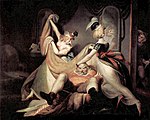Banbury cheese
Banbury cheese was an English cheese produced in
History
Banbury cheeses first appear in the historical record in 1430, when fourteen were sent to
The cheese was renowned in its day. It was given as a gift to several significant figures, including
Historically, Banbury's chief exports were its ale, cheese, and cakes. Banbury ale enjoyed a high of popularity in the Middle Ages, but was virtually unknown outside the town into the 16th century;
The production of Banbury cheese declined into the 18th century; Edward Chamberlayne in 1700, Daniel Defoe in 1727, and Richard Pococke in 1756 were among the last to comment on it.[4][5] By the 19th-century, Alfred Beesley reported in his History of Banbury (1841), "the oft-recorded fame of the town for Cheese has departed from it, and the knowledge of the manufacture of the real "Banbury Cheese" is perhaps now unknown".[9] A special form of Banbury cheese, latter-made cheese, was the last to disappear. By 1840, the number of producers of this cheese was diminishing, and in 1848, for the first time, none was offered for sale at the Banbury fair.[10] Local historian Martin Thomas has speculated that the late-18th-century Inclosure Acts were responsible for the decline in the production of the cheese. As land was taken from commoners and appropriated by new landlords, the new owners may have preferred the more profitable sheep over cattle, and so the town would begin to lack the products necessary for the cheese's production.[6]
Some attempt has been made to revive the cheese. In 1965, a recipe for the cheese was rediscovered. The Historical Society of Banbury attempted to find a cheese-maker to produce the cheese for the November 1969 annual dinner of the Society, but no capable cheese-makers were found, so the enterprise failed.[11]
Description
The cheese was made from cow's milk, with a golden yellow colour and a strong flavour. It was made in rounds, with an outer skin, and was only about one inch thick.
A recipe for the cheese survives in the 15th/16th-century manuscript,
Take a thin cheese vat, and hot milk as it comes from the cow. And run it forth withal in summer time. And knead your curds but once. And knead them not too small, but break them once with your hands. And in summer time salt the curds nothing but let the cheese lie 3 days unsalted. And then salt them. And lay one upon another but not too much salt. And so shall they gather butter. And in winter time in likewise, but then hot your milk. And salt your curds for then it will gather butter of itself. Take the wrung whey of the same milk and let it stand a day or two till it have a cream and it shall make as good butter as any other.[6][11]
Insult
In The Merry Wives of Windsor,
You Banbury cheese!
— The Merry Wives of Windsor (1597), 1.1.126[12]
This insult alludes to the thin proportions of the cheese, especially after its rind was removed, mocking Slender's name and figure.[12]
This comparison was apparently a common one. A variant is found as early as 1538, when James Dyer reported that a judge in the Court of Common Pleas pithily "compared the case to a Banbury cheese, which is worth little when the parings are cut off. And here the case is brief in substance, if the superfluous trifling that is pleaded be taken away".[13] A similar insult is made in Jack Dunn's Entertainment (1601): "Put off your clothes and you are like a Banbury cheese—nothing but paring".[14] According to linguist Frederic S. Marquardt, writing in 1928, "you Banbury cheese" was still in common use as a part of American slang; a simplified descendant of the insult was "you big cheese."[15]
See also
References
- ^ a b c d VCH 1972, "Banbury: Economic history", par. 54.
- ^ a b VCH 1907, "Industries", par. 263.
- ^ a b Foods of England, "Banbury Cheese".
- ^ a b c d e Thomas 2012, p. 275.
- ^ a b VCH 1907, "Industries", par. 264.
- ^ a b c Thomas 2012, p. 276.
- ^ a b c Thomas 2012, p. 274.
- ^ VCH 1972, "Banbury: Economic history", par. 42.
- ^ Beesley 1841, p. 567–8.
- ^ Trinder 1968, p. 29.
- ^ a b Trinder 1970, p. 114.
- ^ a b Merriam-Webster, "7 Shakespearean Insults".
- ^ Parmiter 1979, p. 11.
- ^ Timbs 1863, p. 585.
- ^ Marquardt 1928, p. 119.
Sources
- Beesley, Alfred (1841). The History of Banbury. London: Nichols & Son.
- "Banbury Cheese". The Foods of England Project. Retrieved 18 December 2019.
- Crossley, Alan, ed. (1972). "Banbury: Economic history". A History of the County of Oxford: Volume 10, Banbury Hundred. Victoria County History (VCH). London. pp. 49–71 – via British History Online.
{{cite book}}: CS1 maint: location missing publisher (link) - Marquardt, F. S. (1928). "Shakspere and American Slang". American Speech. 4 (2): 118–122. JSTOR 452868.
- "7 Shakespearean Insults to Make Life More Interesting". Merriam-Webster. Retrieved 18 December 2019.
- Page, William, ed. (1907). "Industries". A History of the County of Oxford: Volume 2. Victoria County History (VCH). London. pp. 225–277 – via British History Online.
{{cite book}}: CS1 maint: location missing publisher (link) - Parmiter, Geoffrey de C. (Autumn 1979). "A Judicial Opinion of Banbury Cheese" (PDF). Cake and Cockhorse. 8 (1): 11. ISSN 0522-0823.
- Thomas, Martin (Spring 2012). "As Thin as Banbury's Cheese". Cake and Cockhorse. 18 (8): 274–276. ISSN 0522-0823.
- Timbs, John (16 May 1863). . Once a Week. Vol. 8. London: Bradbury & Evans. pp. 583–585.
- Trinder, B. S. (Winter 1968). "Banbury Fair in the 19th Century" (PDF). Cake and Cockhorse. 4 (2): 29–31. ISSN 0522-0823.
- Trinder, B. S. (Spring 1970). "Banbury Cheese" (PDF). Cake and Cockhorse. 4 (7): 114. ISSN 0522-0823.

